Jose Angel Araguz's Blog, page 41
April 25, 2016
* new poem up at crab creek review blog!
Just a quick post to share that my poem “El Rio” can be read on Crab Creek Review’s blog!
Along with the poem (which is featured in CCR’s latest issue alongside my poem “Kiss”) are some notes on the background of the piece.
Special thanks to Jenifer Browne Lawrence, Martha Silano, & the whole CCR crew for their continued support and community!
See you Friday!
José


April 22, 2016
* the staying noise of jürgen becker

Hell, Sartre Said, Is Other People – Jürgen Becker
L’heure bleu, it could be, but it’s
the do-it-yourself handyman who makes the mood
for his and my evening. Powerless this entire building –
seventh, eleventh, fourteenth floor; the man
drills into the walls, yet no one
sees him. In case I see him, I’ll, I’ll
do nothing. Like always, complaints go
in the poem, which makes a large staying noise.
translated by Okla Elliott
*
One of my goals in starting this blog four years ago was to celebrate the short lyric, which I see as personal and brief expressions whose tradition extends back to the ancient Greek poet Sappho’s love poems. The way whole worlds, worlds within moments, can be evoked and experienced in a handful of lines is powerful.
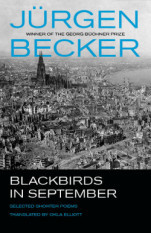 I recently did a microreview/interview of Blackbirds in September, a book of German poet Jürgen Becker’s shorter poems. Time and again I was moved by the personal insight and wisdom found in lines about everyday life. If there are slice of life stories, then I believe the best short lyrics present slices of moments. A short lyric can, indeed, create “a large staying noise” by highlighting what one chooses to recall and archive in a poem as well as giving the reader the artifact of the poem with which to investigate life, the speaker’s and their own.
I recently did a microreview/interview of Blackbirds in September, a book of German poet Jürgen Becker’s shorter poems. Time and again I was moved by the personal insight and wisdom found in lines about everyday life. If there are slice of life stories, then I believe the best short lyrics present slices of moments. A short lyric can, indeed, create “a large staying noise” by highlighting what one chooses to recall and archive in a poem as well as giving the reader the artifact of the poem with which to investigate life, the speaker’s and their own.
The following poem struck me as ingenious not simply for the formal structure but for the inventiveness with which the title’s set up is followed through.
Here, the short lyric serves as an insight to sensibility as much as theme and focus.
*
Possibilities for Paintings – Jürgen Becker
Dark Tree in front of a Bright House.
Wishbodies.
Sad Eyes at the Shutting of Doors.
Wood and Milk; a Lamp.
The Wind, which Extends the Hand (in quotes).
Balloons, Dripping from the Mouth.
Peace in the Valley.
The Patience of Landmines.
Now the Meadow Grows through the House.
Leaping, over a Mark in the Air.
The Coasts of Exile (since 1957).
Winter Branches in Summer.
Triumph of Waiting.
Falling Pears. Lying Pears.
Bicycle on the Horizon.
Soldiers and Bicycle.
The Night of the 7th of November.
The Misery of the Liberated.
Glass, between Figures.
Groups of People before the Horizon.
Fog; the Fossilization of Fog.
translated by Okla Elliott
Check out my microreview/interview on this book and its translator on the Cincinnati Review blog! Thank you to translator Okla Elliott for making these poems available in English!
Happy noising!
José


April 15, 2016
* skimming with kelli russell agodon
Reading through Kelli Russell Agodon’s collection, Letters from the Emily Dickinson Room, I was moved again and again by the kinship evoked between speaker and the poets addressed throughout the poems, but also between poet and craft, and poet to poet. In this week’s poem, “Yakima Ferry at Sunset,” this idea of kinship is there for me from the first line’s declaration:
Tonight I could write a thousand poems
no one should have to read . . .
This line brings to mind a line from Pablo Neruda:
Puedo escribir los versos más tristes esta noche . . .
(Tonight I can write the saddest lines . . .)
This kind of lyric echo speaks to the poet in me, or, rather the poets in me. At times I am the poet of Neruda’s line, lost in reverie and sorrow; at other times, I am the poet of Agodon’s line, possessed by writing, the sheer event of it inspired by the immediacy of a given moment and place.
I often go with my wife to look at fabric or yarn for the projects she’s working on. Walking through the aisles of material, I imagine the possibilities closed to me, but open to anyone who knows how to sew or knit. I can only compare it to the surge of feeling I get when I walk around the woods or body of water in just the right mood, or sit by a window at a café that happens to be in the right light, a feeling of: Today I could write . . .
There’s no guarantee, only a glimpse. One can’t recreate this feeling, one can only acknowledge it for the call to words that it is, and get down what one can, “skimming the edges like every poet.”

Yakima Ferry at Sunset – Kelli Russell Agodon
Tonight I could write a thousand poems
no one should have to read.
All around me are hippie grandmothers
and grey-haired men with dreamcatchers
hanging from the rearview mirrors of their
Hondas. Everyone is irresistable tonight:
the man in his NRA t-shirt, the child
on the upper deck screaming about licorice,
the woman who cut in front of me to buy a latte.
I am skimming the edges like every poet
on this boat, starting my sentences
with the easiest words – I love, I love, I love
to travel home by ferry, the women
who smile at the men they don’t know,
how my tongue feels in my mouth,
a sort of heaviness that never leaves.
*
Happy ferrying!
José


April 13, 2016
* new reprint of The Wall!
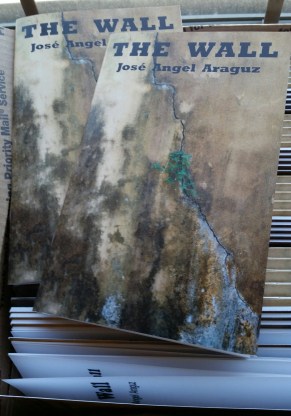
Happy to announce that the latest reprint of my first chapbook, The Wall, has arrived! This reprint is the fourth for my little book that came out in 2012.
If you are interested in a copy, email me at: thefridayinfluence@gmail.com Copies can be purchased via PayPal or check.
There are only forty-four copies, so act fast!
Here’s what poet Naomi Shihab Nye was kind enough to say about The Wall:
“Jose Angel Araguz is a stunning writer. His deep listening – despite walls and silences among them – and his willingness to carry voices of longing and connection even when facts of the world proclaim endless disconnection – help make him a poet of great essential honor and hope. Please welcome him.”
Special thanks to Colette and JoAn at Tiger’s Eye Press for their continued support and belief in the project!
See you Friday!
José


April 8, 2016
* four years of the influence
This week marks the four year anniversary of The Friday Influence. So, as is customary:
Yay!
Sharing poems here continues to be a source of delight and honesty. I say honesty because putting into words some of the journey in understanding a poem, of considering and living with a poem, requires reflection and persistence. Poems are as alive as the poets that write them; this implies change. What I feel one week about a lyric will change given a week, a month, a year away from it. Reaching one week’s point of sharing, finding a particular articulation and current insight, is the happy work I put myself to Friday to Friday. Thanks to all of you who come and share in this work!
This week’s poem – Gary Soto’s “Oranges” – is a poem I have come back to often over the years. Over ten years ago, during a summer in which I carried Soto’s selected poems around with me always, I read and reread those poems, followed his early work’s short lines and vivid imagery. Reading it now, I am still impressed with the ease with which narrative and lyric imagery are combined. There’s one moment in particular that remains captivating:
Outside,
A few cars hissing past,
Fog hanging like old
Coats between the trees.
I’m moved by the way these lines come midway, the image helping to transition between the scenes of the poem, but also by the way the lines could be a poem on their own. The implication is there of things being hard to see, as they are for the speaker in the poem, but there’s also the persistence to see life through moment by glimpsed moment.

Oranges – Gary Soto
The first time I walked
With a girl, I was twelve,
Cold, and weighted down
With two oranges in my jacket.
December. Frost cracking
Beneath my steps, my breath
Before me, then gone,
As I walked toward
Her house, the one whose
Porch light burned yellow
Night and day, in any weather.
A dog barked at me, until
She came out pulling
At her gloves, face bright
With rouge. I smiled,
Touched her shoulder, and led
Her down the street, across
A used car lot and a line
Of newly planted trees,
Until we were breathing
Before a drugstore. We
Entered, the tiny bell
Bringing a saleslady
Down a narrow aisle of goods.
I turned to the candies
Tiered like bleachers,
And asked what she wanted –
Light in her eyes, a smile
Starting at the corners
Of her mouth. I fingered
A nickle in my pocket,
And when she lifted a chocolate
That cost a dime,
I didn’t say anything.
I took the nickle from
My pocket, then an orange,
And set them quietly on
The counter. When I looked up,
The lady’s eyes met mine,
And held them, knowing
Very well what it was all
About.
Outside,
A few cars hissing past,
Fog hanging like old
Coats between the trees.
I took my girl’s hand
In mine for two blocks,
Then released it to let
Her unwrap the chocolate.
I peeled my orange
That was so bright against
The gray of December
That, from some distance,
Someone might have thought
I was making a fire in my hands.
*
Happy making!
José


April 6, 2016
* new book review
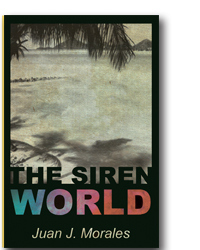 Just a quick post to announce my review of fellow CantoMundo poet Juan J. Morales’s powerful book, The Siren World!
Just a quick post to announce my review of fellow CantoMundo poet Juan J. Morales’s powerful book, The Siren World!
Thanks to Sally & Housten at The Volta Blog for their continued support! Thanks also to Juan for writing such an engaging and heartfelt book!
To read a poem from The Siren World, check out this previous post on the Influence!
See you Friday!
José


April 4, 2016
* radio interview/poetry reading
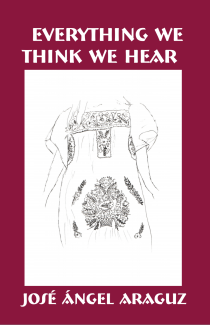 Just a quick post to share my recent interview on WVXU’s “Around Cincinnati.” During the interview, I read “Directions” and “Raro” from Everything We Think We Hear as well as discuss some of the background of the poems and writing process. Enjoy!
Just a quick post to share my recent interview on WVXU’s “Around Cincinnati.” During the interview, I read “Directions” and “Raro” from Everything We Think We Hear as well as discuss some of the background of the poems and writing process. Enjoy!
Special thanks to Kelly Blewett & the WVXU crew for having me!
See you Friday!
José


April 1, 2016
jim harrison remembered
David – Jim Harrison
He is young. The father is dead.
Outside, a cold November night,
the mourner’s cars are parked upon the lawn;
beneath the porch light three
brothers talk to three sons
and shiver without knowing it.
His mind’s all black thickets
and blood; he knows
flesh slips quietly off the bone,
he knows no last looks,
that among the profusion of flowers
the lid is closed to hide
what no one could bear –
that metal rends the flesh,
he knows beneath the white pointed
creatures, stars,
that in the distant talk of brothers,
the father is dead.
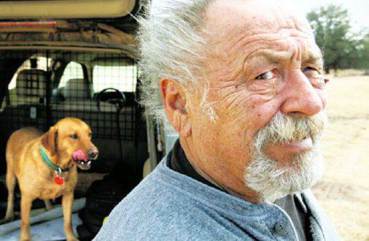
The unanswered question is why a poet transforms experience, not so much to make it understandable, but to make it yield its aesthetic possibilities
— Jim Harrison
This is one of the quotes I carry with me from notebook to notebook as a reminder of why I write and what’s at stake. Pushing words to not just describe but to evoke life for others is a worthy endeavor, and one that the late Jim Harrison worked at book after book.
The poem above is a good example of what is meant in the quote. The poem describes one person’s experience of grief after a death. Yet, rather than being elegy, the poem gathers its human details (parked cars; shivering) and sets them against memories that keep edging in on the person grieving. The calm juxtaposed against the violence is where the son lives now, and is part of the new world without the father.
Another example of this kind of transformation of human details into aesthetic possibility is found in the following poem by Ted Kooser. Kooser and Harrison were friends and co-authored the book Braided Creek: A Conversation in Poetry. The poem below, which does a great job of turning over a human moment of grief for what it can further say about living, shows Kooser to be also working at the worthy endeavor Harrison will be remembered for.
Mourners – Ted Kooser
After the funeral, the mourners gather
under the rustling churchyard maples
and talk softly, like clusters of leaves.
White shirt cuffs and collars flash in the shade:
highlights on deep green water.
They came this afternoon to say goodbye,
but now they keep saying hello and hello,
peering into each other’s faces,
slow to let go of each other’s hands.
*
Happy handing!
José
p.s. For more Jim Harrison, check out these previous posts, one featuring a poem, and another featuring some notes on his novel The English Major.


March 28, 2016
* new poem up at zócalo public square
Just a quick post to share that my poem “Element” has been published at Zócalo Public Square! Please check it out!
Thanks to Colette Speer for the opportunity!
See y’all Friday!
José


March 25, 2016
* layers via michael s. harper & basho
Village Blues – Michael S. Harper
The birds flit
in the blue palms,
the can workers wait,
the man hangs
twenty feet above;
he must come down;
they wait for the priest.
The flies ride on the carcass,
which sways like a cork in a circle.
The easter light pulls hims west.
The priest comes, a man
sunken with rum,
his face sandpapered
into a rough of split
and broken capillaries.
His duty is cutting
down the fruit
of this quiet village
and he staggers slowly, coming.
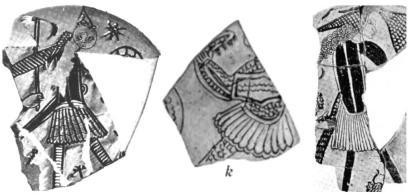
Sgraffito, I learned recently, is a technique used in both wall decor and ceramics in which contrasting colors are layered across a surface, only to be then scratched into so as to reveal parts of the underlying layer. The result is an image made of a specific depth and texture.
This week’s poem – “Village Blues” by Michael S. Harper – performs via language in a way similar to sgraffito. Harper writes of a hanged man’s body by choosing to write about the life going on around it. In describing the birds, workers, even the flies at the scene, Harper layers the daily lives of the village over the dead body, and thus makes the presence of the lost life all the more felt. The description of the priest, too, as he “staggers slowly, coming” to the body, becomes imbued with the unspoken. Through indirect association, everything in the village “sways” along to the village’s “blues.”
These thoughts also bring to mind the following haiku by Basho, where the layered images give way to something deeper:
On the white poppy,
a butterfly’s torn wing
is a keepsake
*
Happy winging!
José





